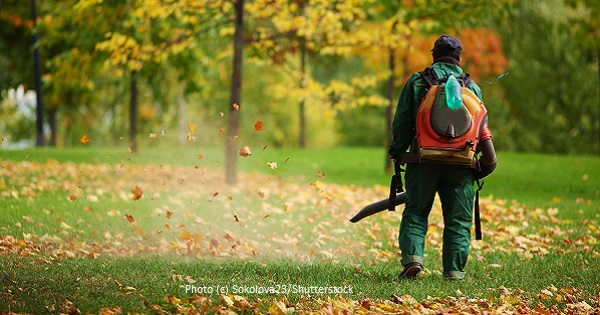|

The Problem with Leaf Blowers
By Wendy Priesnitz
Where I live, there are lots of leaves on the ground this time of year. That means there are also lots of leaf blowers in use. In many cases, landscaping companies use them year-round to clear pathways, sidewalks, and driveways from freshly mowed grass. Supporters say these noisy, smelly beasts are the most efficient way to keep lawns and sidewalks neat, and point out that some older people are not able to rake. However, there are a number of serious downsides to their use.
First, there’s the noise. The roar of a typical gasoline-powered, two-stroke leaf blower registers at between 90 and 112 decibels on the noise measuring scale. As I wrote in this article about noise pollution, anything over 75 decibels can be problematic for our hearing. The top end of the leaf blower noise scale is reportedly louder than an airplane taking off, a freight train going by, or being at a live rock concert.
Then there’s what they blow around, along with the leaves. Leaf blowers circulate allergens, toxins, pollutants like herbicides and pesticides, and pathogens into the air, along with dust. Fallen leaves – especially in damp climates – grow mold. And mold is an allergen. Mold allergies can create the same symptoms as other seasonal irritants: itchy, watery eyes, runny nose and nasal congestion, sore throats, and headaches. Leaf mold can also make asthma worse. The American Lung Association recommends that everyone avoid leaf blowers due to the toxic dust they create. A study published by the California Environmental Protection Agency in 2000 found that landscape workers running a leaf blower are exposed to ten times more ultra-fine particles than someone standing next to a busy road.
As part of a campaign to have leaf blowers banned in one New York town, doctors at Mt. Sinai Children's Hospital's Environmental Health Center signed a letter detailing concerns about their effect on health. It read, in part:
“Leaf blowers pose multiple hazards to human health. Children are the most susceptible members of our population to these hazards because they breathe more air per pound of body weight per day than adults and thus inhale more of any pollutants that are thrown into the air by this equipment. Children's vulnerability to the health effects of this equipment is further magnified by the fact that … their lungs, ears, eyes, and other organ systems are inherently more sensitive to environmental hazards than the organs of adults.”
Then there are the environmental issues. The two-stroke engine is used in leaf blowers (and other similar equipment) because it’s lightweight, inexpensive, and relatively powerful. But those qualities mean it’s a simple piece of equipment and very inefficient. Powered by a gasoline and oil mixture, the engine creates incomplete combustion, which causes it to discharge toxins like carbon monoxide, nitrous oxides, and hydrocarbons. Carbon monoxide is toxic in high concentrations and contributes to smog formation. Nitrous oxides are a major contributor to global warming and acid rain. Hydrocarbons are volatile organic compounds that are often carcinogenic and also contribute to smog.
The annual emissions from one leaf blower are estimated to be the same as 80 automobiles being driven 12,500 miles. In fact, according to the California Air Resources Board, by 2020, leaf blowers and other similar small gas engines will collectively emit more ozone pollution in California than all that state’s passenger cars. For that reason, it plans to lower allowable emission levels from those small gas engines by 85 percent, starting in 2020.
Leaf blowers also are fatal to insects and other small creatures. This is especially important in light of recent warnings that our insect population is rapidly declining, threatening global biodiversity and our food supply. In fact, one report has referred to it as a coming insect armageddon. As a result, in 2019, the German government has told its citizens that leaf blowers should only be used if absolutely necessary.
As a result of this negative impact, many municipalities actually ban the use of leaf blowers. Other towns and cities have opted to persuade commercial landscapers to use low-emission leaf blowers, which use more efficient four-stroke engines instead of two-stroke ones. Electric leaf blowers are another alternative.
So, if you must use a leaf blower, get an energy-efficient one. Use ear protection. Be purposeful about where you’re blowing the leaves and associated other nasty stuff, collecting them for compost or mulch rather than just blowing them into the street. Warn those in the immediate area to stay clear and to close their house and car windows.
But maybe the old fashioned rake is still the best choice. The Los Angeles Department of Power and Water once conducted a test that compared the efficiency of an older woman using a rake and broom with that of a professional landscaper with electric and gas leaf blowers. In three test cycles, the woman with her rake cleaned the area more quickly than any of the battery-powered blowers and 80 percent as fast as the gas-powered leaf blowers. She also did a better job cleaning up the areas, says the report.
At any rate, naturalists and gardening experts suggest that we leave all those leaves right where they fall, in order to provide winter refuge for insects and other wildlife, and to fertilize our lawns and gardens. Now there’s a win-win if I have ever seen one!
Wendy Priesnitz is the editor of Natural Life Magazine. She is also the author of thirteen books, including Natural Life Magazine's Green & Healthy Homes, which provides more information on topics like this one.
|

